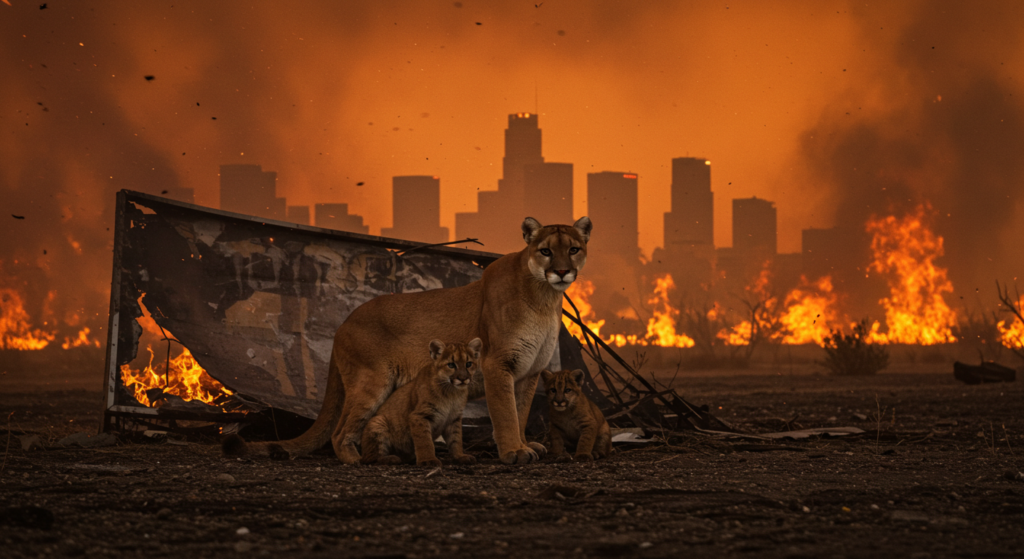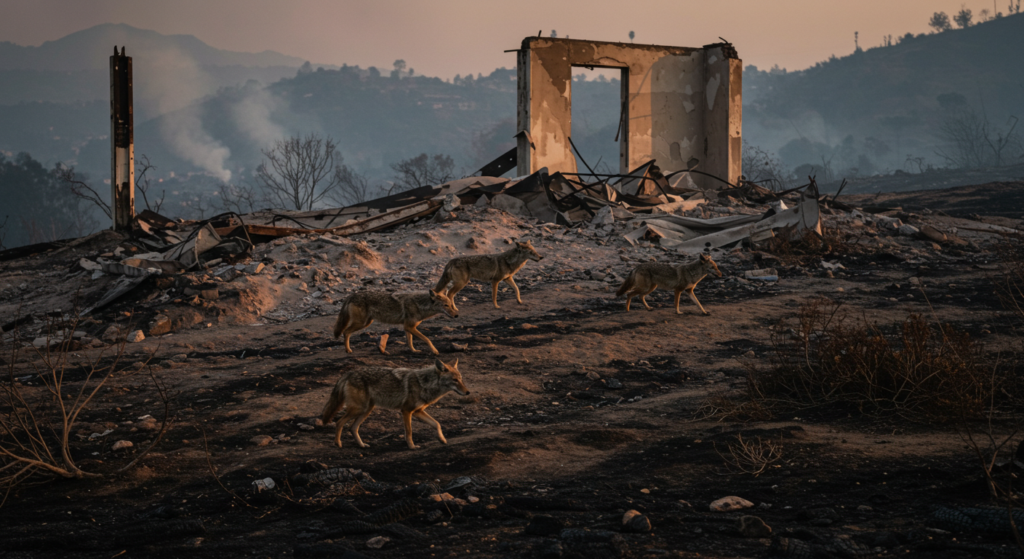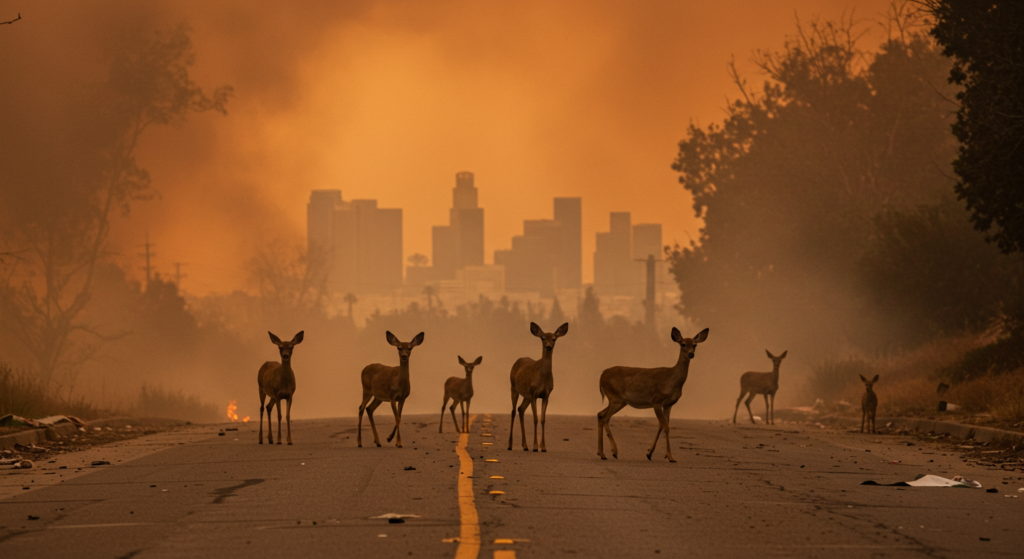
Imagine your home ablaze, the air thick with smoke, and escape your only option. This is the terrifying reality for countless animals when wildfires tear through Los Angeles. These ferocious fires not only destroy homes and livelihoods but also devastate the intricate web of life within affected ecosystems. We will explore the harrowing experiences of wildlife caught in the crosshairs of these devastating blazes, shedding light on their struggles for survival in the face of unprecedented destruction.
Wildlife in LA’s Wildfire Zones
Los Angeles County is home to a diverse range of wildlife, from mammals and birds to reptiles and insects. When wildfires sweep through the region, these creatures are often caught within the fire’s devastating path. Unlike animals outside the infected zones, these animals face the dual threat of fire and the immediate aftermath, such as habitat loss, starvation, and increased vulnerability to predators.


Animals Commonly Found in Affected Areas
- Mammals:
- Mountain Lions (Puma concolor): These elusive predators are heavily affected by wildfires. Many are displaced, forced to flee burned-out hunting grounds. Studies have shown that they avoid burned areas for months due to lack of cover and prey.
- Coyotes (Canis latrans): Often seen scavenging in suburban areas post-fire, coyotes adapt quickly but struggle with food shortages in the immediate aftermath.
- Deer (Odocoileus hemionus): Deer are particularly vulnerable during fires, with many unable to escape fast-moving flames. Survivors often suffer from injuries like burns or smoke inhalation.
- Birds:
- California Quail (Callipepla californica): Ground-nesting birds like quail lose their nests during wildfires, leading to a sharp decline in population.
- Red-tailed Hawks (Buteo jamaicensis): Predatory birds lose hunting grounds and may become disoriented during fires, often flying into smoke-filled zones.
- Owls: Owls such as the great horned owl (Bubo virginianus) struggle as their prey, like rodents, either flee or perish.
- Reptiles and Amphibians:
- Western Fence Lizards (Sceloporus occidentalis): Lizards often burrow underground to escape fires but are vulnerable to heat that penetrates the soil.
- Snakes: Many snake species, such as gopher snakes and western rattlesnakes, are trapped in their hiding spots, unable to escape quickly.
- Insects:
- Pollinators: Bees and butterflies face population collapses as wildfires destroy flowering plants they depend on for survival.
- Ants and Beetles: Although some species are adapted to fire-prone ecosystems, intense fires can decimate entire colonies.

Also Read
The Role of Santa Ana Winds in the Southern California Fires!
Rich vs. Poor: How the LA Fires Highlight Inequality.
Challenges Faced by Wildlife in Burn Zones
- Habitat Destruction:
Wildfires completely obliterate vegetation, leaving animals without shelter or food. The once-thriving ecosystems become barren landscapes where survival is a daily struggle. - Injuries and Health Issues:
- Burns: Many animals suffer severe burns to their paws, wings, or skin while attempting to escape the flames.
- Smoke Inhalation: Prolonged exposure to thick smoke causes respiratory distress in mammals and birds.
- Starvation: With vegetation and prey populations wiped out, herbivores and predators alike face starvation.
- Increased Predation:
The loss of cover leaves smaller animals vulnerable to predators. For instance, rodents and rabbits are easy prey for coyotes and hawks in the open landscapes created by fires. - Displacement and Stress:
Animals forced to flee burned areas often encroach on human settlements, leading to conflicts. Coyotes, mountain lions, and bears are frequently sighted near urban neighborhoods post-fire, searching for food and water.
Efforts to Rescue and Rehabilitate Animals
- Animal Rescue Operations:
Organizations like the California Wildlife Center and the Pasadena Humane Society play a crucial role in rescuing injured animals. Their teams venture into burned areas to save animals suffering from burns and dehydration. - Rehabilitation:
- Medical Treatment: Burned animals receive treatment for wounds and infections, often requiring weeks of intensive care.
- Feeding Stations: Wildlife agencies set up temporary feeding stations in affected areas to support displaced animals.
- Relocation:
In cases where habitats are completely destroyed, wildlife is relocated to safer areas. For instance, mountain lions and deer may be transported to unburned wilderness regions.
Impact on Ecosystems
Wildfires in LA not only devastate individual animals but also disrupt entire ecosystems. For example, pollinators like bees are vital for plant regeneration, but their decline affects the recovery of vegetation. Similarly, predators like mountain lions maintain balance in the food chain, and their displacement leads to overpopulation of prey species in some areas.
Voices of Rescuers
Animal rescuers working in wildfire zones share harrowing stories of their efforts:
- Austin Muhs, a renowned rescuer, described saving over 100 animals during a recent LA wildfire. “These animals are helpless in the face of such devastation. It’s heartbreaking, but we do everything we can to give them a second chance,” he said.
- Pasadena Humane Society Teams: Volunteers noted that many pets and wild animals show signs of extreme stress post-fire, requiring not just medical care but also emotional support.
Make Your Mark
Wildfires are a natural phenomenon, but their increasing intensity and frequency, fueled by climate change, pose an existential threat to wildlife. Protecting these animals requires a multifaceted approach:
- Supporting wildlife rescue organizations.
- Reducing fire risks through sustainable land management.
- Promoting awareness of the impact of wildfires on ecosystems.
The resilience of wildlife is remarkable, but without human intervention, many species may struggle to recover. By taking action today, we can ensure a future where LA’s rich biodiversity continues to thrive.